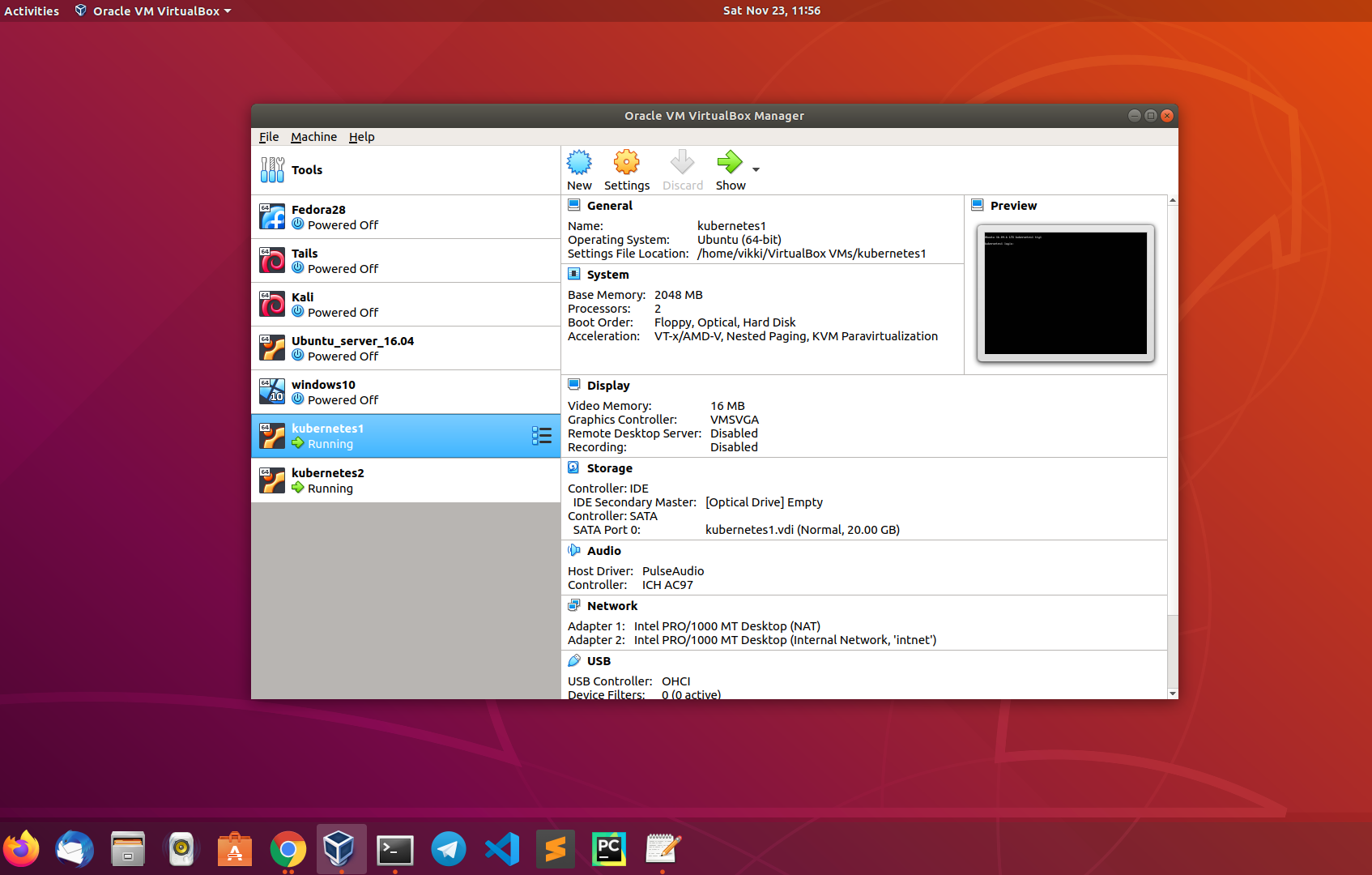on
Creating persistent local-storage volume in Kubernetes
PersistentVolume and PersistentVolumeClaim in kubernetes provides a way to allocate storage for the pods. Kubernetes PV supports different types of storage. Now here in the below post we are going to use storage-class local-storage and watch the behaviour for different reclaimpolicy.
Setup
I am using the Virtualbox(running in Ubuntu 18.04 physical machine) for this entire setup . The physical machine is Dell inspiron laptop with 12GB RAM , Intel® Core™ i7-6500U CPU @ 2.50GHz × 4 and 512GB SSD hardisk.

Step 1: Create a directory in one for the node and add a file
root@kubernetes2:~# mkdir /pvdir
root@kubernetes2:~# echo "Hello world!" > /pvdir/index.html
root@kubernetes2:~# cat /pvdir/index.html
Hello world!Step 2: Get the label of the node
We need to get the label of the node where the directory is created.This we need to configure in the nodeAffinity specs in order to properly stick the pod to respective node where the local volume is present.
vikki@kubernetes1:~$ kubectl get nodes --show-labels
NAME STATUS ROLES AGE VERSION LABELS
kubernetes1 Ready master 19d v1.16.2 beta.kubernetes.io/arch=amd64,beta.kubernetes.io/os=linux,kubernetes.io/arch=amd64,kubernetes.io/hostname=kubernetes1,kubernetes.io/os=linux,node-role.kubernetes.io/master=
kubernetes2 Ready <none> 19d v1.16.2 beta.kubernetes.io/arch=amd64,beta.kubernetes.io/os=linux,kubernetes.io/arch=amd64,kubernetes.io/hostname=kubernetes2,kubernetes.io/os=linuxStep 3: Create a persistent volume(PV)
Create a PV and map the local storage director and configure the label in the node selector
vikki@kubernetes1:~$ vim pv.yamlvikki@kubernetes1:~$ kubectl create -f pv.yaml
persistentvolume/vikki-pv-volume createdStep 4: Verify the PV status
Verify the PV status. It is currently configured with access type RWO and reclaim policy as Delete
vikki@kubernetes1:~$ kubectl get pv
NAME CAPACITY ACCESS MODES RECLAIM POLICY STATUS CLAIM STORAGECLASS REASON AGE
vikki-pv-volume 1Gi RWO Delete Available local-storage 14sStep 5: Create a persistent volume claim(PVC)
Create a PVC and map the above created PV
vikki@kubernetes1:~$ vim pv_claim.yamlvikki@kubernetes1:~$ kubectl create -f pv_claim.yaml
persistentvolumeclaim/vikki-pv-volume-claim createdStep 6: Verify the PVC status
Verify the PVC and PV status. Now we can see the status changes from Available to Bound.
vikki@kubernetes1:~$ kubectl get pvc
NAME STATUS VOLUME CAPACITY ACCESS MODES STORAGECLASS AGE
vikki-pv-volume-claim Bound vikki-pv-volume 1Gi RWO local-storage 8s
vikki@kubernetes1:~$ kubectl get pv
NAME CAPACITY ACCESS MODES RECLAIM POLICY STATUS CLAIM STORAGECLASS REASON AGE
vikki-pv-volume 1Gi RWO Delete Bound default/vikki-pv-volume-claim local-storage 3m59sStep 7: Create a pod and map the PVC
Create a pod and map the volumes as below
vikki@kubernetes1:~$ kubectl run --image=nginx nginx-pod --generator=run-pod/v1 --dry-run -o yaml > pod.yamlvikki@kubernetes1:~$ vim pod.yamlvikki@kubernetes1:~$ kubectl create -f pod.yaml
pod/nginx-pod createdStep 8: Verify the pod status and volume inside
Verify the status of the new pod and check the volume is mounted inside the container
vikki@kubernetes1:~$ kubectl get pods
NAME READY STATUS RESTARTS AGE
fluentd-elasticsearch-bwhfx 0/1 ImagePullBackOff 0 4h3m
fluentd-elasticsearch-pvlpv 0/1 ImagePullBackOff 0 4h3m
nginx-85ff79dd56-zqllr 1/1 Running 1 5h51m
nginx-pod 1/1 Running 0 10sroot@kubernetes2:~# docker ps -a |grep nginx-pod
e142048a048f nginx "nginx -g 'daemon of…" 20 seconds ago Up 20 seconds k8s_nginx-pod_nginx-pod_default_b6b900bb-b214-4b96-bc90-18b2358ee225_0
df59f401a38a k8s.gcr.io/pause:3.1 "/pause" 26 seconds ago Up 25 seconds k8s_POD_nginx-pod_default_b6b900bb-b214-4b96-bc90-18b2358ee225_0root@kubernetes2:~# docker exec -it k8s_nginx-pod_nginx-pod_default_b6b900bb-b214-4b96-bc90-18b2358ee225_0 cat /usr/share/nginx/html/index.html
Hello world!Now we can see the directory from the PV is mounted in the pod and the files created are present
Verify reclaim policy(Below steps are Optional)
Step 9: Delete PVC and verify PV
Now delete the pod and PVC and verify the status of PV
vikki@kubernetes1:~$ kubectl delete pod nginx-pod
pod "nginx-pod" deletedvikki@kubernetes1:~$ kubectl delete pvc vikki-pv-volume-claim
persistentvolumeclaim "vikki-pv-volume-claim" deletedvikki@kubernetes1:~$ kubectl get pv
NAME CAPACITY ACCESS MODES RECLAIM POLICY STATUS CLAIM STORAGECLASS REASON AGE
vikki-pv-volume 1Gi RWO Delete Failed default/vikki-pv-volume-claim local-storage 5m30sWe can see the staus of PV is automaticall changed to Failed. This is due the the reclaim policy Delete
Step 10: (Optional ) Try recreate PVC
We can optionally try recreating the PVC volume and verify the status
vikki@kubernetes1:~$ kubectl create -f pv_claim.yaml
persistentvolumeclaim/vikki-pv-volume-claim createdvikki@kubernetes1:~$ kubectl get pv
NAME CAPACITY ACCESS MODES RECLAIM POLICY STATUS CLAIM STORAGECLASS REASON AGE
vikki-pv-volume 1Gi RWO Delete Failed default/vikki-pv-volume-claim local-storage 5m57s
vikki@kubernetes1:~$ kubectl get pvc
NAME STATUS VOLUME CAPACITY ACCESS MODES STORAGECLASS AGE
vikki-pv-volume-claim Pending local-storage 2m10sWe can see the status of PV is still Failed and the PVC always in Pending and never creates
Step 11: Delete and create PV with reclaim policy as retain
Now lets clean up all PV and PVC and recreate PV with reclaim policy set as “Retain”
vikki@kubernetes1:~$ kubectl delete pvc vikki-pv-volume-claim
persistentvolumeclaim "vikki-pv-volume-claim" deleted
vikki@kubernetes1:~$ kubectl delete pv vikki-pv-volume
persistentvolume "vikki-pv-volume" deletedvikki@kubernetes1:~$ vim pv.yaml
persistentVolumeReclaimPolicy: Retainvikki@kubernetes1:~$ kubectl create -f pv.yaml
persistentvolume/vikki-pv-volume created
vikki@kubernetes1:~$ kubectl create -f pv_claim.yaml
persistentvolumeclaim/vikki-pv-volume-claim createdvikki@kubernetes1:~$ kubectl get pvc,pv
NAME STATUS VOLUME CAPACITY ACCESS MODES STORAGECLASS AGE
persistentvolumeclaim/vikki-pv-volume-claim Bound vikki-pv-volume 1Gi RWO local-storage 99s
NAME CAPACITY ACCESS MODES RECLAIM POLICY STATUS CLAIM STORAGECLASS REASON AGE
persistentvolume/vikki-pv-volume 1Gi RWO Retain Bound default/vikki-pv-volume-claim local-storage 118sStep 12: Delete the PVC and verify the status of PV
Now lets delete the PVC and verify the status of the PV
vikki@kubernetes1:~$ kubectl delete pvc vikki-pv-volume-claim
persistentvolumeclaim "vikki-pv-volume-claim" deletedvikki@kubernetes1:~$ kubectl get pv
NAME CAPACITY ACCESS MODES RECLAIM POLICY STATUS CLAIM STORAGECLASS REASON AGE
vikki-pv-volume 1Gi RWO Retain Released default/vikki-pv-volume-claim local-storage 2m11sNow we can see the status of PV changes to “Released” instead of “Failed” due to the reclaim policy “Retain”
Discussion and feedback